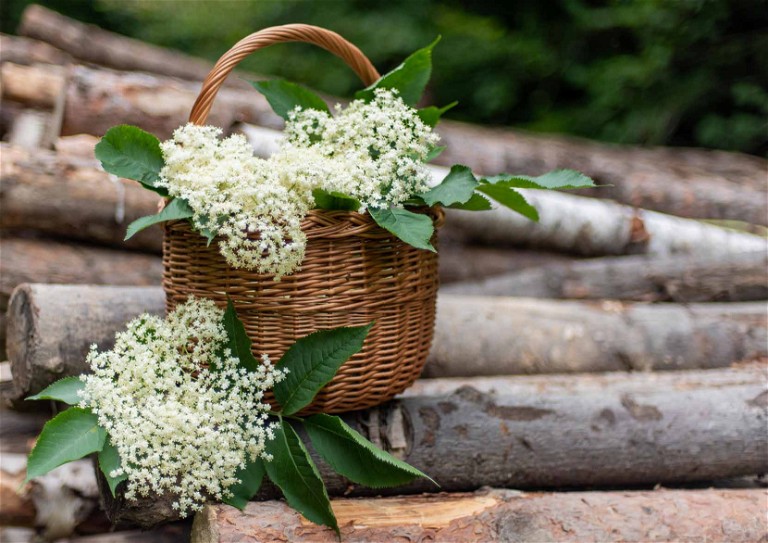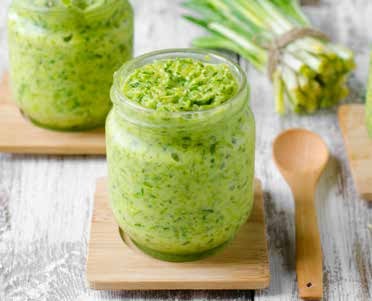
GET INTO FORAGING
Woody River shares the joys of discovering wild food, and gives some practical tips for those looking to get started
Would you like a fresh supply of organic, nutritious, free food? What if I said you could have all this, while developing a closer connection with your local landscape?
As a vegan of 32 years, there are many reasons I love foraging. All foraging walks are a delight as I am never entirely sure what I will find.
Foraging enables me to cut down on plastic packaging throughout late spring and summer when wild food is so plentiful, and partly into autumn too. My food bills are greatly reduced as I harvest fresh salad ingredients on my daily walks, and I enjoy spending part of my weekends making drinks, meals and condiments which I preserve to last me through the colder months.
Conservation
Apart from knowing which plants are not safe to eat, the most important aspect of foraging is conservation. Since the 1930s, there has been huge habitat decline in the UK. It is therefore vital to protect plant populations by only picking small quantities at a time from colonies which are large enough to withstand some harvesting. Most edible plants reproduce by seeds usually formed from the flowers, so it is important to be restrained when harvesting flowers – if the colony is small, only pick the leaves. Remember also that many animals rely on plants for their food, especially birds and insects, so conserve plant populations for them. To start your foraging journey, here are ten commonly found and easy-to-use plants to look out for this summer.
"Apart from knowing which plants are not safe to eat, the most important aspect of foraging is conservation. Since the 1930s, there has been huge habitat decline in the UK. ”
To start your foraging journey, here are ten commonly found and easy-to-use plants to look out for this summer.
Do not eat any wild plant unless you are sure it is safe. A comprehensive plant identification guide will help you to feel confident in your decisions, whereas some plant identification apps can often be inaccurate.
Wild thyme can be found on walls, rocks or field edges
Dandelion
Easy to find throughout the year, young dandelion leaves can be used in salads or cooked like spinach as a side vegetable. To use the flowers, shake them well and pull off the petals, as they often harbour tiny black insects. Infuse the petals in oil or vinegar for flavoursome dressings or use to make wine or tea. For a coffee substitute, chop and roast the roots for 40 minutes at 350 °C and then simmer.
Elderflower
The delicate creamy-yellow blooms of elder trees are a delight to find in summer hedgerows. Pick them with a good stem attached and shake them well to remove little insects. Elderflower can be used to make cordial or wine.
Note of caution: elderflower has some nasty lookalikes, so exercise caution when picking.
Garlic mustard
With broad leaves and a head of little white flowers, garlic mustard grows in woodlands and hedgerows. Only pick them if there are lots available, as they only produce flowers and seeds in the second year. Steam the stem and flowerheads like tender stem broccoli, then add a drizzle of olive oil, some freshly ground black pepper and a twist of lemon. It is heaven on a plate.
Hairy bittercress
Look for this plant on dry, bare ground and in cracks in walls and pathways. At its base is a rosette of multiple individual leaf stems, each with small round leaves growing opposite each other in pairs along the length of the stem. Out of this rosette protrudes a tall spindly stem with tiny white flowers on top. Use the leaves, stems and flowers like rocket as a spicy addition to salads and sandwiches.
Lime tree
If you are fortunate enough to live near a lime tree, stand beside it on a summer evening and breathe in the sweet honey scent from its blossoms. It is intoxicating! Use the flowers fresh or dried, infused in boiling water for 5–10 minutes for a relaxing tea which may help to induce sleep.
Nettles
High in iron and useful for lowering blood pressure, young nettle tips can be cooked like spinach or made into a simple soup by frying chopped ramsons and then adding nettles and diced potatoes with a little water. Boil until the potatoes are soft, then add soya or oat milk, salt, pepper and a pinch of nutmeg before liquidising. Wear sting-proof gloves when you are harvesting them and avoid the older leaves which are too bitter.
Ramsons/wild garlic (featured on magazine cover)
In late spring and early summer, some ancient woodlands become carpeted in long, broad, dark green leaves from which emerge heads of white star-like flowers. These vast colonies of ramsons can be harvested for use in salads, soup, pesto and any other dish which requires a leafy vegetable and some garlic.
Note of caution: check your harvested leaves carefully because two poisonous plants sometimes grow among ramsons, namely dog’s mercury and lords and ladies.
Wild mint
There are many varieties of mint to choose from. If you find it growing in a field or wood it is likely to be corn mint, but if you find it by water, and its leaves are almost purplish, it is probably water mint. This has a stronger taste so should be used sparingly. Apple mint lives on verges and dry waste grounds, and has slightly paler and less pointed leaves. Use mint leaves to make tea, flavour summer drinks or, for a special treat, sprinkle on top of chocolate ice cream.
Wild thyme
This low-growing plant with dark pinkish-lilac flowers and small dark green leaves often forms dense fragrant mats on top of cliffs, but enjoy any dry habitat such as walls, rocks or field edges. Use it in salad dressings and to infuse vinegar or add to mushroom dishes for an extra zing.
Watercress
If you have a stream near you, check whether there is watercress growing there. Harvest throughout the year, except during frosts, but be careful to avoid pulling up the whole plant. Instead, cut the upper parts of the leafy stem, including the flowers.
Note of caution: if there are sheep or cattle grazing nearby, wash very thoroughly to avoid being infected with liver fluke, a nasty parasite. If in doubt, cook it to make watercress soup.
Preserving your foraged foods
Freezing
If you have used your harvest in a cooked recipe, the easiest way to preserve it is to freeze it. Most food lasts for three months when frozen.
Drying
When harvesting wild herbs, pick them in the morning and shake them to remove insects. Tie them in small bunches to avoid rot or mould forming, place them in a paper bag and hang them upside down in a warm, well-ventilated room out of direct sunlight and humidity for 2–3 weeks. A quicker method, if you have the space, is to pick off the leaves and lay them on a tray for 3–4 days.
Storing in bottles or jars
After washing your bottles or jars in hot soapy water, sterilise them by using the highest setting of your dishwasher cycle. Alternatively, heat the oven to 140 °C, place a sheet of baking paper on one of the shelves, lay out the bottles so they are not touching and keep them in for 20 minutes. Use the bottles or jars as soon as possible and remember to also sterilise the lids.
Woody River runs foraging walks in the South of England.
Visit secretlandscapes.co.uk to find out more.
RECIPES

Ramsons Pesto
Ingredients
150 g ramsons (leaves, flowers and stems) 65 g cashews, almonds or walnuts 2–4 tbsp nutritional yeast flakes 1 lemon 100 ml olive oil Salt and pepper
Directions
Wash and dry the ramsons, checking carefully for snails, slugs and bird droppings. Also check to make sure there are no other leaves included. Chop the leaves and add in batches to a food processor, scraping down the sides in between blitzing. Add the nuts, yeast flakes, a squeeze of lemon and then the olive oil a drizzle at a time to desired consistency. Add salt and pepper to taste. Store it in a sterilised glass jar or plastic tub in the fridge for up to five days or freeze in small portions for three months.
Elderflower Cordial
Ingredients
4 unwaxed lemons
30 elderflower heads
2 litres boiling water
1 kg sugar
Directions
Cut two lemons in half and place them in a large bowl with the clean elderflower heads. Pour the boiling water over the top and cover with muslin cloth overnight. The next day, strain the mixture through the muslin and then heat the liquid in a pan, adding the remaining lemon juice and sugar. When the sugar has dissolved, simmer for three minutes before pouring into sterilised bottles or jars. Store the cordial in a cold place and consume it within two weeks.
